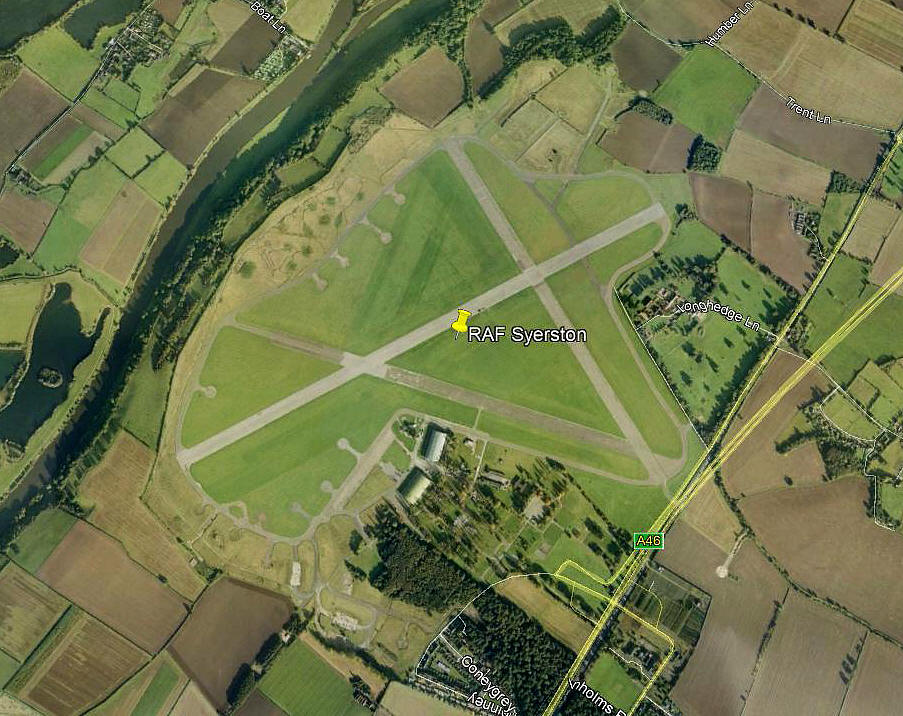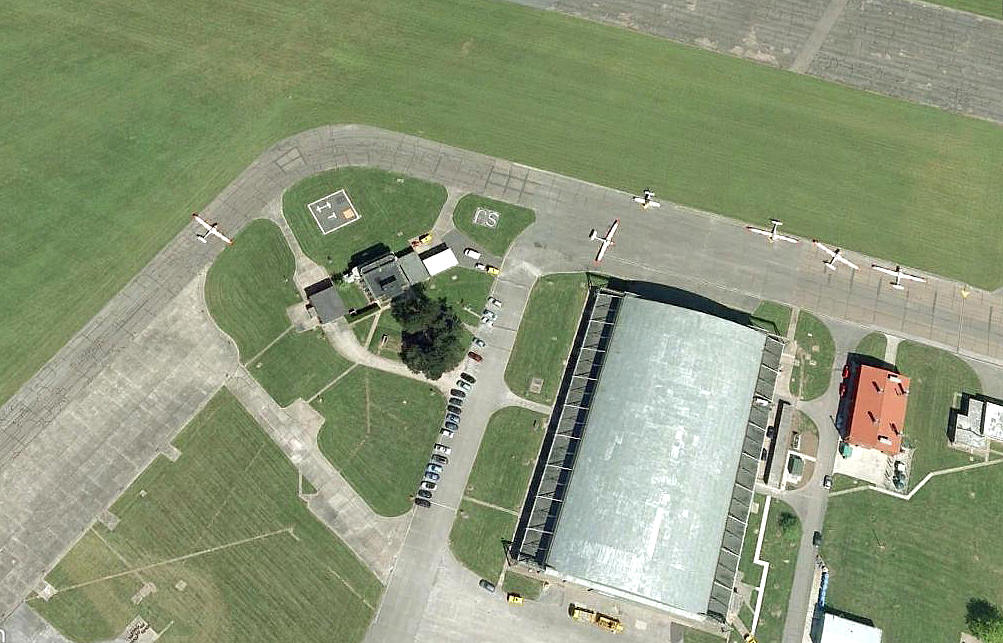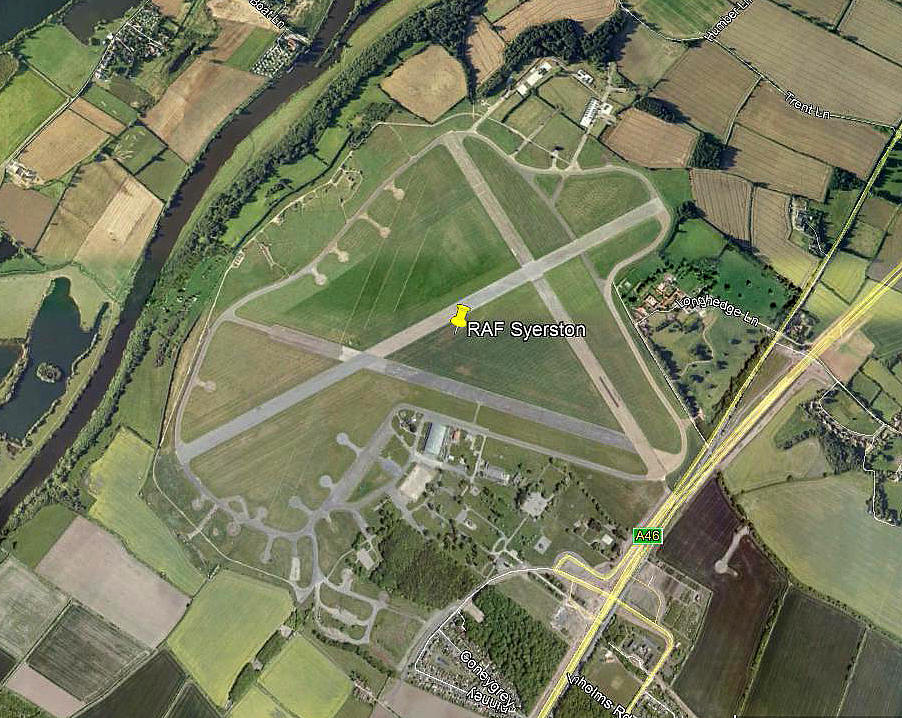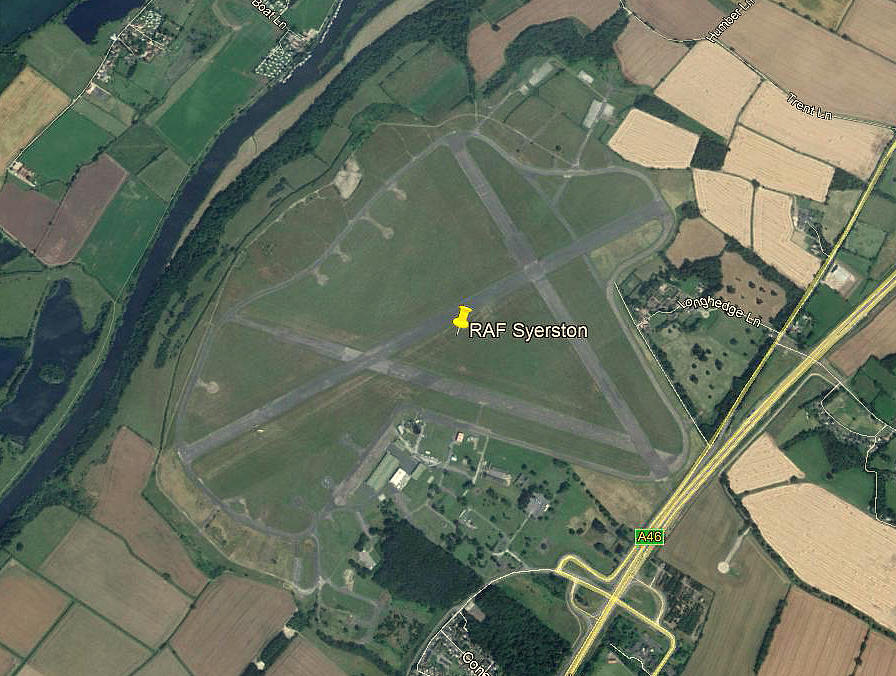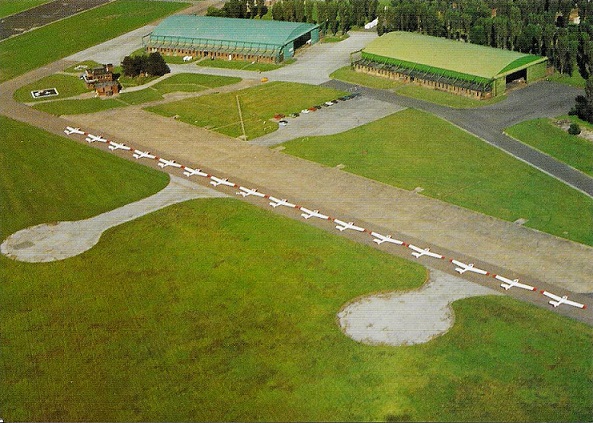Syerston
SYERSTON: Military aerodrome later gliding site
Note: All four of these pictures were obtained from Google Earth ©
Military users: WW2: RAF Training Command
1333 TSCU
RAF Bomber Command 5 Group
49 (Rhodesia) Sqdn (Avro Lancasters)
61 & 106 Sqdns (Avro Manchesters later Avro Lancasters)
304 & 305 (Polish) Sqdns (Vickers Wellingtons)
408 (RCAF) Sqdn (Handley Page Hampdens)
5 LFS (Lancaster Finishing School)
Note: This picture from a postcard was kindly sent by Mike Charlton who has an amazing collection. See, www.aviationpostcard.co.uk
It would appear to me that the aircraft, (presumably Grob types), were deliberately laid out, in line, for this picture to be taken. If anybody can kindly provide a date and advice, this will be most welcome.
Post 1945: RAF Training Command
RN Air Section trained by No.22 Flying Training School (Tiger Moths & Percival Prentices)
2 FTS
CGS (Central Gliding School)
2000s (Grob Vigilant T1 and Grob Viking T1)
Note: From 1975 (Moved from SWANTON MORLEY)
Flying club/school: 1959 ‘snapshot’. RAF Syerston Flying Club, RAF Syerston Flying Group
In the 1957 The Aeroplane directory, the R.A.F. Syerston Flying Group are listed.
Gliding: 1981: Four Counties Gliding Club (RAFGSA)
643 & 644 VGS (Volunteer Gliding Squadrons)
Note: It appears that 643 & 644 VGS merged in 2012
2000s: 644 VGS (Grob Viking T1)
Location: WNW of Syerston and A46, SE of Gibsmere, 5nm SW of Newark on Trent
Period of operation: 1940 to -
Runways: WW2: 07/25 1783x46 hard 12/30 1280x46 hard
16/34 1280x46 hard
NOTES: Still a major RAF Station in late 1944 with a large complement of 2596 men and 414 WAAFs listed.
At some point when 22 FTS were training Fleet Air Arm ab intio pilots a ‘carrier length’ section was marked off on one runway, presumably 07/25? Apparently the Commanding Officer, “.. had a go himself just to show them that it could be done with safety….he was a man who led from the front.”
A REPORT
Regarding the bombing operations of WW2, Patrick Bishop in his excellent book Wings describes an unusual event that took place here. “It was a civilian, the BBC reporter Richard Dimbleby, who put into words the bowel-melting, yet awe-inspiring nature of the sight, when he bravely flew to Berlin with Guy Gibson and 106 Squadron on the night of 16-17 January 1943.” Guy Gibson was soon to achieve enormous fame exactly five months later when he led the ‘Dambusters’ raid on the 16-17 May. “They took off from Syerston at tea time. ‘It was a big show as heavy bomber ops go,’ he broadcast later. ‘It was also quite a long raid, as the Wing Commander who took me [Gibson] stayed over Berlin for half an hour. The flak was hot, but it has been hotter. For me it was a pretty hair-raising experience and I was glad when it was all over, though I wouldn’t have missed it for the world. But we must all remember that these men do it as a regular job’.
I now think it is very important indeed to remember that the British population had virtually no idea about what the bombing campaign of Germany actually involved, as indeed did the people serving on the ground at bomber Stations. My mother was a WAAF at RAF LINDHOLME (LINCOLNSHIRE) and when the war ended was one of many taken on a flight in a Lancaster to see what had been achieved. She told me that far from being elated she was appalled at the extent of the devastation. She had no idea and was left feeling far from proud to have taken a small part in it.
She passed away a long time ago and I still wonder how she would feel, many years later, to hear that one of her sons, having the huge benefit of hindsight and having studied the subject in considerable detail, is now absolutely certain that every single bomb that fell on Germany was totally justified. A country which, I think I should say, I am very fond of having spent a lot of time working in, and having had many very enjoyable holidays. If anything it has taught me to never associate a race of people with the machinations of their political leaders. Neither historically or at the present time.
A TERRIBLE ACCIDENT
On the 20th September 1958, when performing a low-level fly-past along the main runway during a 'Battle of Britain At Home' display, the right wing of the prototype Avro Vulcan VX770 started breaking up and it dived into the ground on the airfield. All the crew perished as did three in the controllers caravan near the runway. The exact cause was it seems, never determined.
ALSO POST WW2
It is said that the Burgoyne Stirling Dicer G-AECN flew from here for a brief period in the late 1940s - can this be confirmed? This aircraft, apparently a cobbled together BAC Drone and Dart Pup must surely be a pretty significant example of early ULAA types? Can anybody add to this?
In 1990 to 2000 noted for intensive gliding activity seven days a week.
Ady Stimpson
This comment was written on: 2017-12-05 21:47:06Good evening again. I have some photos of Squadron Leader Keith Sturt's final resting place. He was the pilot of VX770. He is buried close by where I live.
Reply from Dick Flute:
Hi Ady, Perhaps it might be something to be included? All part of our aviation history of course. I have already included a couple of pictures regarding the final resting place of very famous British aviators. So why not include others of considerable merit. My best regards, Dick
We'd love to hear from you, so please scroll down to leave a comment!
Leave a comment ...
Copyright (c) UK Airfield Guide















